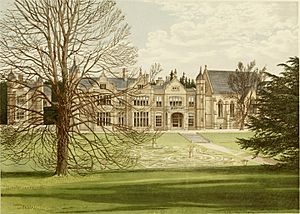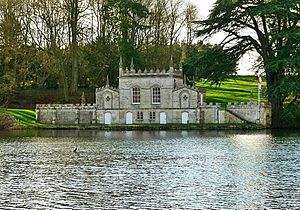Exton Hall facts for kids

Exton Hall is a grand country house in England. It sits on the western edge of the village of Exton, Rutland, in a very large park.
Discovering Exton Hall
Exton Hall has been the home of important families for almost 400 years. First, it was the home of the Harington family, and later the Noel family, who were known as the Earls of Gainsborough.
The original mansion at Exton Hall burned down in 1810. Today, only its ruins remain. These ruins still show off beautiful gables and chimneys, much like other large houses from the Elizabethan era (a period in English history when Queen Elizabeth I ruled).
The current Exton Hall was built in the 1800s, not far from the old ruins. In 1869, a special Roman Catholic chapel was added to the house. It was designed by Charles Alban Buckler. During World War II, parts of the U.S. Army Air Force used the hall.
Today, Exton Hall is still a private home. It belongs to Henry Noel, Viscount Campden, and his family. The house is not usually open to the public. However, it is sometimes used for a few special private weddings.
Exton Hall is also linked to a famous old story called the Legend of the Mistletoe Bough.
Exploring Exton Park
Inside the park, you can find a charming building called Fort Henry. It was built in 1788 in a fancy Gothick style. This building overlooks beautiful lakes that were formed by the North Brook stream.
The park around Exton Hall is very big. It spreads across several villages, including Exton, Cottesmore, Greetham, and Horn.
In 1948, the owner of the park allowed a company to dig for ironstone there. From 1957 to 1974, a giant machine called Sundew worked the land. Sundew was the world's largest walking dragline, a huge digging machine. After it finished digging, Sundew slowly walked all the way to another town called Corby.
Materials from the quarry were moved by a railway. This railway had a nine-mile loop and connected to another railway line near what is now the Rutland Railway Museum.



